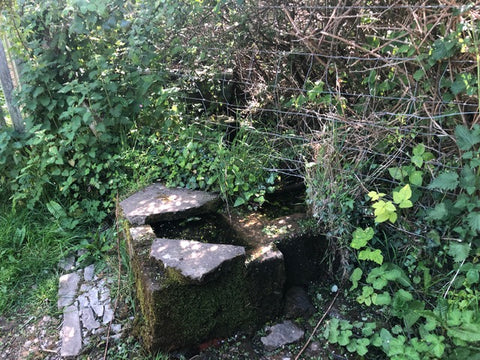May 02, 2021
For those who are unfamiliar, the Great Orme is a headland that can be found on Wales‘s north coast. It is believed that the name comes from the Old Norse orm or urm, which means “sea serpent.” In fact, some people might have guessed that orm or urm share an origin with the English worm that is still sometimes used to describe dragons as well as other serpentine monsters.
Regardless, considering the name, it should come as no surprise to learn that the Great Orme possesses some measure of resemblance to a sea serpent. However, there is some disagreement on what that resemblance might be. Sometimes, interested individuals say that the Great Orme is the head to the tail to the Little Orme’s tail, with the land between the two headlands serving as the main length of the beast. Other times, the resemblance is said to lie in the look of the Great Orme itself when one approached it from the sea. Whatever the case, the headland is a much storied place, thus making it an excellent place to start for those who likes to learn more about mysterious Wales.

Rush Hour in Wales Stretched Canvas
For those who are curious, here are a couple of the stories about the Great Orme and its surroundings:
The Hiding Cave is a small cave with a source of freshwater in the form of a spring well. Supposedly, it was once inhabited by Saint Tudno, a one-time prince who decided to study at the monastery of Bangor Iscoed so that he could make recompense for the incompetence of his father.
Interesting fact: Tudno was reputed to be one of the seven sons of King Seithenyn of the drowned Cantref-y-Gwaelod, the legendary land that lies beneath the water of Cardigan Bay.

This is the view above Ogof Llech or Hiding Cave.
From the Hiding Cave, he spread his faith to the local people, with the result that he was eventually able to build a church on the headland.
When St Tudno (the patron saint of Llandudno) built his cell on the Great Orme Head in the sixth century, he is reputed to have had in his possession one of the thirteen marvels of Britain. It was a magic whetstone that had the amazing property of being able to tell a brave man from a coward. When a coward tried to sharpen his weapon upon the stone it only made it more blunt, but brave man could put a razor edge on his sword.
St Tudno’s feast day is celebrated on 5th of June.
The 6th century church no longer stands, but there is a 12th century structure dedicated to Saint Tudno on the site that is open to interested individuals.

St. Tudno's Church. 
The church was extended in the 15th century, and succumbed to the violent storms of the Great Orme in 1839 when its roof was blown away and the church was abandoned at this point. Although few restoration took place between 1855 and 1906, still the structure has some interesting features: the font probably dates from the 12th century; there are some early sepulchral stones and two 13th century coffin lids.
Now, lets go back to the Hiding Cave.
The Hiding Cave lives up to its name in the sense that it isn’t very accessible, so much so that people have found it easier to approach it from the sea rather than from the land. Something that isn’t helped by the fact that time has made the stone steps into something that shouldn’t be chanced.
However, it should be mentioned that there is a fair amount of interest in the Hiding Cave, not least because there are clear indications that it was used after Saint Tudno’s time. One, the walls have been lined with sandstone, which is not a local building material. Two, there is a statue that has been interpreted to be that of an angel. Three, there is what could be the remnant of a round stone altar. Combined, these curious characteristics have caused some to believe that the Hiding Cave was turned into a religious site for crusaders returning from the Holy Land, which perhaps unsurprisingly, has triggered a fair amount of frenzied speculation. After all, even though the military orders have long since faded from societal prominence, they remain a subject of much interest, not least because of modern theorists wondering what they may or may not have been involved with over the course of their documented existence.

Abbey Road Llandudno Goats Unisex T-shirt
This spring on the Great Orme is a water source that doesn’t seem to dry up, even in the driest weather. There is a story associated with the well, which tells of its mysterious formation.


Ffynnon Powell. In Welsh, ffynnon means fountain, well or spring.
Many years ago, the Powell family lived in a dwelling close to where the well is now situated. One summer there was a severe drought on the Great Orme, not only did the animals suffer, but the Powell family suffered too. Due to some local dispute between the Powell’s and all of their neighbours, they were not allowed to go near any water sources on the Orme, or they would be killed, it was that serious. In desperation the family went to the above mentioned St Tudno’s church to pray to God for his help. When they returned to their home afterwards, they found to their amazement and joy a bubbling spring close to their front door. The spring is named after the Powell family.
This arrangement of stones is the remains of a burial chamber, or cromlech, from about 6,000 to 4,500 years ago.

Llety'r Filiast Dolmen.
This type of chamber, commonly used in the Neolithic era, is known as a portal dolmen. The space below the horizontal stone would have contained the remains, possibly cremated, of important members of a family or community.
It is described by Frances Lynch “Prehistoric Wales” (1995):
This is one of the few north Welsh tombs to have a folk name. Llety’r Filiast means ‘The Lair of the Greyhound Bitch’, a name which, with variation, has been applied to several other tombs elsewhere in Wales. Unfortunately no story survives to explain it (Lynch 1995: 19).
Most megaliths like dolmens were scared in ancient times and associated with mystic powers. It is said sick people were brought to megaliths shaped like dolmens in the belief dolmens have healing power, and funeral corteges paused at dolmens to put souls of the dead at rest.
Whatever the case, nobody knows for sure why dolmens were built.
There was once an Iron Age hill fort at this area called Pen Dinas on the Great Orme. Archaeologists have identified the remains of more than fifty hut circles and some degraded defensive ramparts. Pen Dinas is subsidiary peak that juts out of the Great Orme, and it is a good defensive location for a settlement.

The Rocking Stone on the Great Orme looking towards the West Shore.

The 'Rocking Stone' 'Maen Sigl' on the Great Orme, Llandudno overlooking the Little Orme.
There is also a peculiar stone at Pen Dinas known as the ‘Rocking Stone’. It has a plaque on it, so you will be able to find it. 12th-century poet Gwalchmai ap Meilyr, in his ‘Guide to Llandudno’, says that this rocking stone may have been used by druids (an ancient Celtic religion) for judging people accused of certain crimes. The blindfolded prisoner would be put on the rock – if the stone rocked the Druids would shout, ‘He is innocent.’ If the rock didn’t move they would shout, ‘He is guilty, over the cliff with him!’
In Wales stone hammers have been found at twenty-six sites indicating that in the Bronze Age the two main concentrations of copper mining activity lay in North Wales at Parys Mountain and here on the Great Orme in Llandudno. The Great Orme was the largest of these mines and was worked for over 1,000 years.

Interesting fact: The mine was first worked during the Bronze Age, around 4000 years ago, about the same time as Stonehenge was being built.
It has been estimated that Bronze Age man mined enough copper to produce over 10 million bronze axes.
In 2005 this mine was announced as ‘the largest prehistoric copper mine in the world’.
Having said that, it should be mentioned that the Great Orme continues to be a source of much discussion in the present time. Some of it is connected with the mysteries of its past. However, there are new mysteries that offer new opportunities for fascination.

Great Orme Summit Complex UFO room
The Great Orme is supposed to be one of the most popular sites for UFO sightings as well as related phenomenon in the whole of the United Kingdom, which is saying something considering that country’s reputation among UFO enthusiasts.
References:
February 23, 2025
Every year on March 1st, Wales comes alive with celebrations in honor of St David (Dewi Sant)—the nation’s beloved patron saint. But who was this remarkable figure, and why is he so important to Welsh history?
February 05, 2025
Did you know that just like birthstones, each month has its own special birth flower? These beautiful blooms hold unique meanings, making them a thoughtful and personal gift for birthdays!
February 04, 2025
Finding the perfect birthstone jewellery can be simple and enjoyable with our help
